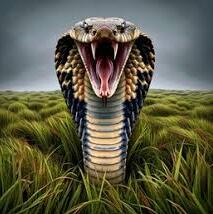Cobras are some of the most iconic and dangerous snakes in the world, known for their intimidating hood and potent venom. But even these feared reptiles are not invincible. In nature, several animals have evolved to hunt and eat cobras, showcasing incredible strategies for survival. In this article, we’ll explore what animals eat cobras, their hunting techniques, and why cobras are not at the top of the food chain.

The mongoose is perhaps the most famous predator of cobras. These small, agile mammals are known for their remarkable ability to take down venomous snakes, including cobras. But how does a mongoose, a relatively small animal, manage to defeat such a deadly predator?
Quick Reflexes: Mongooses are incredibly fast, allowing them to dodge the quick strikes of a cobra.
Thick Fur: Their dense coat offers some protection from snake bites, making it harder for venom to penetrate.
Immunity to Venom: Mongooses have a special biological advantage—partial immunity to snake venom. While a bite from a cobra might slow them down, it’s rarely fatal.
Mongooses attack cobras by provoking the snake into striking, then using their speed to avoid the venomous bite. They eventually go in for the kill by biting the cobra’s head, rendering it defenseless.
Several species of birds of prey are also capable of hunting and eating cobras. These birds have excellent vision and powerful talons that allow them to grab and immobilize their prey from the air.
Sharp Talons: Eagles, particularly the serpent eagle, are equipped with sharp talons that allow them to snatch up cobras before the snake can react.
Powerful Beaks: Once caught, the eagle uses its beak to deliver fatal blows to the snake’s head or neck.
Aerial Advantage: Attacking from the air gives these birds a significant tactical advantage, allowing them to ambush cobras from a safe distance.
Though cobras pose a risk, especially when on the defensive, these birds are highly skilled hunters, and they have perfected the art of capturing snakes in their native environments.
Honey badgers have a reputation for being fearless, and their diet includes a wide variety of animals, including cobras. Their aggressive nature, combined with their physical toughness, makes them one of the few animals that will actively hunt venomous snakes.
Thick Skin: Honey badgers have incredibly tough skin, which provides protection against cobra strikes.
Immunity to Venom: Like mongooses, honey badgers possess a certain level of resistance to snake venom. Even if bitten, they are capable of shaking off the effects and continuing the fight.
Powerful Jaws: Once the badger has caught the cobra, it uses its powerful jaws to crush the snake's head.
Honey badgers are known to be relentless and will not back down even from dangerous prey like cobras, making them formidable predators in their habitats.
It may seem surprising, but one of the most effective predators of cobras is actually other king cobras. King cobras are not only the largest venomous snakes in the world, but they are also known to consume other snakes, including members of their own species.
Opportunistic Feeding: King cobras are opportunistic feeders, and if food is scarce, they won’t hesitate to eat other snakes, including smaller cobras.
Dominance in the Snake World: As apex predators among snakes, king cobras have few natural enemies. They can easily overpower smaller species of cobras and other snakes.
This unique behavior demonstrates how the food chain operates even within the same species, highlighting the ruthless efficiency of survival in the wild.
While animals like mongooses and eagles have natural methods of hunting cobras, humans also pose a significant threat to cobra populations. In many cultures, cobras are hunted for their skins, venom, and sometimes even their meat. Additionally, cobras are often killed when they encroach on human settlements or present a danger to livestock.
Venom Harvesting: Cobra venom is highly sought after for medical research and antivenom production.
Cobra Skin Trade: Cobras are hunted for their skin, which is used in fashion items like belts, bags, and shoes.
Habitat Destruction: Human expansion and habitat destruction also threaten cobra populations, as their natural environments are altered or destroyed.
Although humans may not “eat” cobras in the traditional sense, they certainly play a role in the decline of cobra populations across many regions.
While cobras are apex predators in their own right, they are far from invincible. Animals like mongooses, birds of prey, honey badgers, and even other cobras all play a part in keeping cobra populations in check. Understanding what animals eat cobras sheds light on the complex relationships within ecosystems and the intricate balance of nature.
Whether through speed, strength, or sheer immunity to venom, these cobra predators are fascinating examples of how various species have adapted to thrive, even in the presence of one of the world’s most dangerous snakes.
By learning more about cobra predators, we gain insight into the importance of each species in maintaining the equilibrium of their environments.
animal tags: cobras
We created this article in conjunction with AI technology, then made sure it was fact-checked and edited by a Animals Top editor.